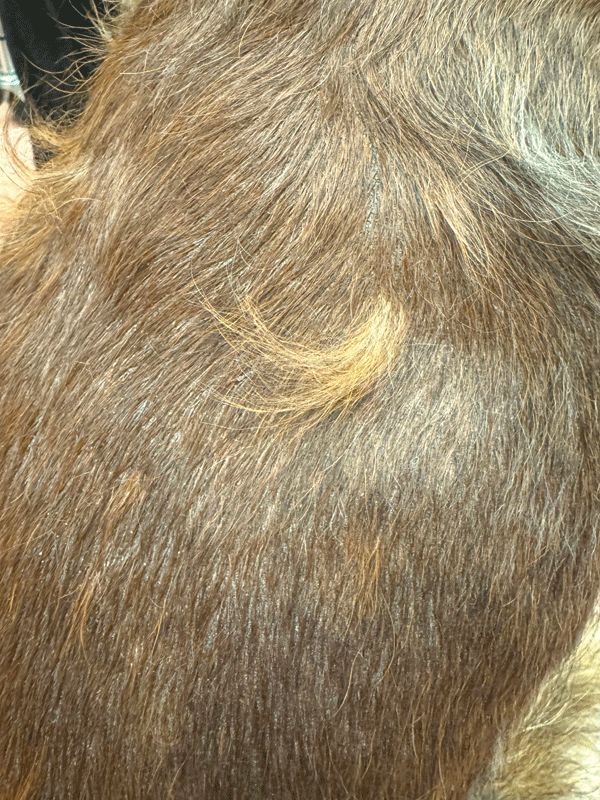
Refractory allergy cases can be frustrating to manage and treat. Plus, troubleshooting the lack of response to therapy can be time-consuming and costly. As a result, when evaluating challenging or nonresponsive allergy cases, it is important to keep in mind there are several, nonallergic skin diseases that can mimic the clinical signs of allergies and may require very different treatment plans. The most common allergy mimickers include pemphigus foliaceous, sebaceous adenitis, dermatophytosis, and demodicosis. Understanding the clinical presentation of these disease processes can help differentiate mimickers from refractory allergic cases.
Allergy mimicker 1): Pemphigus foliaceous
Pemphigus foliaceous (PF) is an immune mediate disease that targets the connections between the skin cells and cause keratinocyte acantholysis. PF is most common in middle-aged to older dogs, with Akitas and chow chows appearing to be overrepresented.1
Clinical lesions of pemphigus that can mimic allergic disease include pustules, erythema, crusting, erosions, ulceration, and alopecia.1,2 Pruritus is variable in pemphigus cases but can often be marked like allergic disease. However, unlike allergic disease, pemphigus will often cause discrete, moist, serous crusts, pustules, and erosions/ulcerations on the nasal planum, pinnae, and paw pads.1,2
Additionally, due to the systemic inflammation secondary to pemphigus foliaceous, many affected animals will have concurrent signs, including lethargy, decreased appetite, weight loss, depression, and fever, which are uncommon with allergic disease.
PF is generally diagnosed via biopsies, but cytology may be helpful, as well. The most common diagnostic finding on both histopathology and cytology is neutrophilic inflammation with acantholytic kertatinocytes.1
Treatment: Immune suppressive treatment for pemphigus foliaceous is long-term in most cases. One of the mainstays of therapy is glucocorticoids. Although steroids provide rapid anti-inflammatory and immune suppressive effects, due to the risks of long-term high dose glucocorticoid use, steroid-sparing agents are often used in combination with steroids to treat pemphigus. Common steroid-sparing agents include azathioprine, cyclosporine, and myocophenolate.2
A recent study found oclacitinib also has steroid-sparing effects in the management of pemphigus foliaceous.3 Finally, one small study showed an injectable polysulfated glycosaminoglycan may also provide steroid-sparing effects in these cases and can be an adjunctive therapy.4 Careful and frequent bloodwork monitoring is recommended throughout management and prognosis is fair pending response to treatment.
Allergy mimicker 2): Sebaceous adenitis
Sebaceous adenitis (SA) is thought to be an immune mediated disease that results in inflammation and subsequent destruction of the sebaceous glands. SA is generally seen in young to middle-aged dogs and is commonly diagnosed with biopsies showing loss or destruction of sebaceous glands. Poodles and their mixes, Akitas, Havanese, vizslas, and Samoyeds are predisposed to the disease. In both standard poodles and Akitas, an autosomal recessive mode of inheritance has been determined.5

Similar to allergies, early SA lesions are erythema and scaling with varying levels of pruritus. However, as the disease process progresses, the scaling becomes more marked, forming follicular casting and hair coat changes, including hair texture and color, and alopecia can occur.1,5
Additionally, pruritus is generally milder compared to allergic disease unless secondary infection is present. Finally, similar to allergies, many cases of SA will have concurrent otitis externa, but the cerumen consistency in SA cases is often drier and crumblier compared to normal waxy cerumen. Sebaceous adenitis is most commonly diagnosed with biopsies showing loss or destruction of sebaceous glands.
Treatment: Treating SA focuses on topical therapy to remove scales and replace oils and systemic therapies to help reduce the destruction of the sebaceous glands. The most common topical therapies include shampoos, humectants, and oil replacement soaks.5 Topical oil replacement soaks with baby oil can be very effective, but they are often too labor-intensive for owners.
Cyclosporine is one of the most common systemic therapies and is often used as a sole therapy or in combination with topical therapy. Oral retinoids also can be beneficial in treatment of SA, but the availability and side effect potential often limit their use. Vitamin A is a natural retinoid and can be helpful in combination with other systemic medications and topical therapies. Although topical and systemic therapies can be effective as sole therapy, the synergistic effect of combined therapy tends to provide the most rapid improvement.
As sebaceous adenitis is primarily a cosmetic disease, long-term prognosis is good. However, hair regrowth is variable and may be a different color or texture than the original hair coat. Finally, due to the natural waxing and waning of the disease process, long-term therapy is generally necessary.
Allergy mimicker 3): Dermatophytosis
Dermatophytosis is a superficial cutaneous fungal infection in dogs and cats. The most common dermatophytic species include Micorsporum canis, Microsporum gypseum, and Trichophyton mentogrophytes. Dermatophytosis is contagious amongst other pets in the house and has a high zoonotic potential.1,6 Persian cats and terrier dogs, particularly Yorkshire and Jack Russell terriers, appear to be predisposed.
Clinical signs of this infection include alopecia, erythema, scaling, crusts, and papules, which are similar to many allergic signs.1,6 However, dermatophytosis often results in asymmetrical, well-demarcated patches of affected skin adjacent to normal skin.6 Additionally, pruritus levels with dermatophytosis can be variable, but are generally minimal. Finally, dermatophytosis can also affect the claws which is less commonly seen in allergic dermatoses.
Diagnosis of dermatophytosis is important to differentiate from allergic and immune-mediated diseases, since use of immune modulators will potentially exacerbate the infection. While there is not a gold standard for diagnosing dermatophytosis, dermatophytosis cultures (DTM) and PCR testing are valuable tools for confirming a diagnosis and monitoring response to therapy.1,6
Treatment: Treating dermatophytosis usually includes a combination of topical and systemic antifungal therapies. Antifungal shampoos can be helpful to speed resolution and decrease environmental contamination. Lime sulfur can be used weekly as sole therapy or in combination with oral antifungals. Itraconazole and terbinafine are considered the most effective systemic antifungals for dermatophytosis.6 Finally, since infectious arthrospores can live on the hairs and skin cells for months and serve as source for reinfection, environmental decontamination is also important for management of dermatophytosis.
Treating dermatophytosis should aim for both a clinic cure (resolution of skin lesions) and mycological cure (negative results on DTM/PCR).
Allergy mimicker 4): Demodicosis
Canine demodicosis is most commonly caused by over-proliferation of a normal commensal follicular mite Demodex canis, and can be classified as juvenile onset in dogs less than 18 months of age or as adult onset in older animals. While demodicosis is more common in young dogs, it is important with adult onset to evaluate for potential underlying disease process that can result in immune suppression and over proliferation of mites. Common underlying disease include hypothyroidism, hyperadrenocorticism, iatrogenic immune suppression, or neoplasia.1,7
Additionally, demodicosis can be divided into localized forms with five or fewer lesions and generalized demodicosis.1,7
Historically, demodicosis was known as “red mange” due to the skin inflammation and erythema often seen in affected dogs. Similar to allergic signs, in addition to erythema, scaling, alopecia, and papules/pustules can be cutaneous changes seen with dermodicosis.1,7 However, comedone formation with secondary folliculitis and furunculosis are also commonly seen with demodectic manage.
Further, demodicosis is generally nonpruritic, and pruritus in these cases is usually the result of a secondary pyoderma. In severe cases,systemic signs, including lethargy, fever, and lymphadenopathy can be present.7
Deep-skin scrapings are the gold standard for diagnosis of demodicosis,1,7 and should be performed as part of the baseline dermatological database.
Treatment: Historically, macrocyclic lactones, including ivermectin, milbemycin, and moxidectin, were the mainstay of treatment for canine demodicosis.1,7 However, the isoxazoline class of ectoparasiticides has been used as an effective and well-tolerated treatment. At this point, in most cases, isoxazolines are considered the first-line treatment of choice for canine demodicosis.
In addition to treating the mites, managing any secondary bacterial infections in these cases is important. Cytology to evaluate for secondary infection is recommended throughout treatment of demodicosis. Skin scrapes should be repeated until two negative skin scrapes at least four weeks apart are obtained.1,7 In most cases of juvenile demodicosis, relapses are uncommon. If the underlying trigger of immune suppression is identified and controlled, most adult-onset cases will also not reoccur after treatment.
Nonallergic diseases should be considered in any case in which there is incomplete or poor response to common treatments for suspected allergies. While there is a marked overlap in clinical signs between allergic dermatoses and allergy mimickers, the subtle difference in clinical presentations can help differentiate non-allergic disease processes from allergies and streamline recommendations for further testing.
Rebecca Mount, DVM, DACVD, earned her Bachelor of Science in biology from the University of New Mexico in 2005, and her doctorate of veterinary medicine from Colorado State University College of Veterinary and Biomedical Sciences in 2009. Following graduation, Dr. Mount completed an internship in small animal medicine and surgery at Garden State Veterinary Specialist in New Jersey. She began her residency with Dermatology for Animals in 2010, and became a diplomate of the American College of Veterinary Dermatology in 2014.
References
- Miller, WH., Campbell, KL., Griffin, CE. Mueller and Kirk’s Small Animal Dermatology 7th edition (various pages). St. Louis, Missouri: Elsevier.
- Rosenkrantz, WS. Pemphigus: current therapy. Veterinary Dermatology. 2004;(15):90-98.
- Herneandez-Bures, AH, Bidot, WA, Griffin, CE., et al. The use of oclacitinib compared to azathioprine in the management of canine pemphigus foliaceous: A retrospective analysis. Veterinary Dermatology. 2023; (34): 554-566.
- Simpson, A, Roseychuck, R, Schissler, J, et al: Polysulfated Glycosaminoglycan as a Novel, Adjunctive Therapy for Pemphigus Foliaceous in Three Dogs. JAAHA. 2019 (55): 318-322
- Pye, Charlie. Canine sebaceous adenitis. The Canadian Veterinary Journal. 2021; (62): 293-296.
- Moriello, KA, Coyner, K., Paterson, S., et al. Diagnosis and treatment of dermatophytosis in dogs and cats. Veterinary Dermatology. 2017 (28): 266-268.
- Mueller, RS., Rosenscrantz, W., Bensignor, Em., et al. Diagnosis and treatment of demodicosis in dogs and cats. Veterinary Dermatology. 2020; (31): 4-e2
